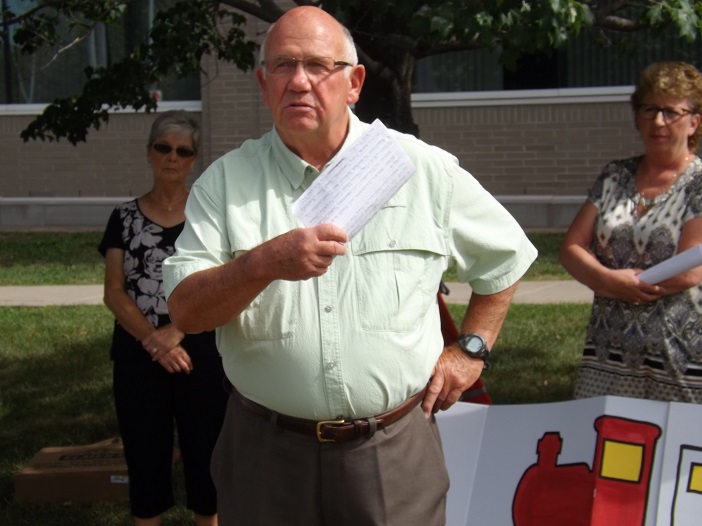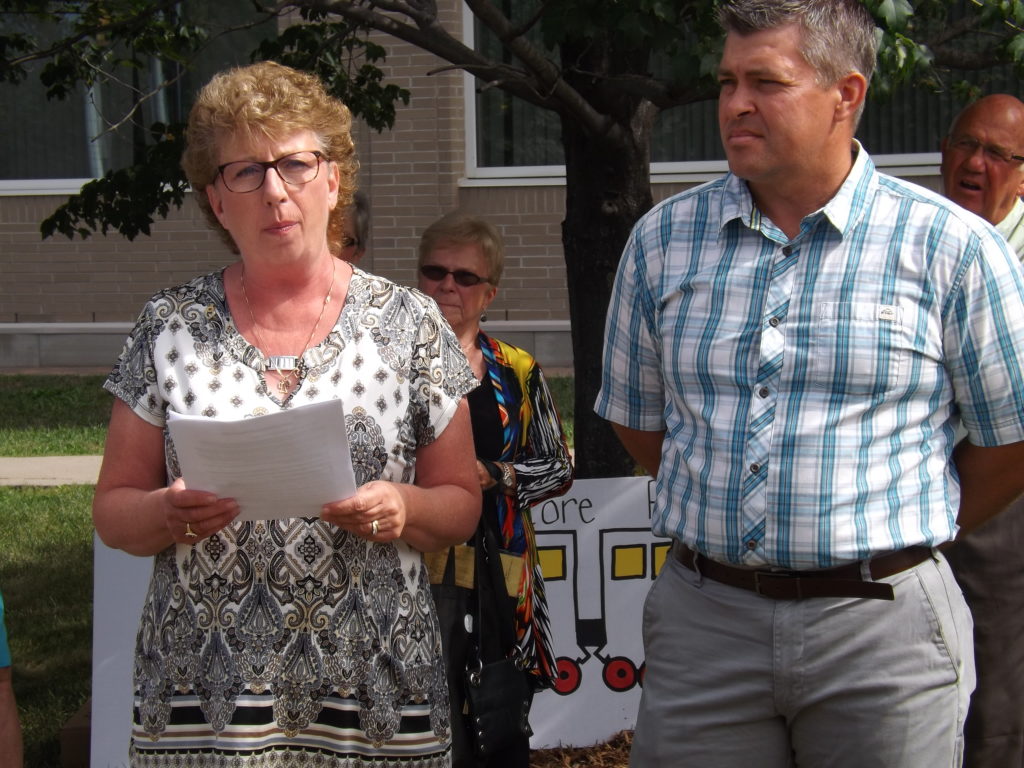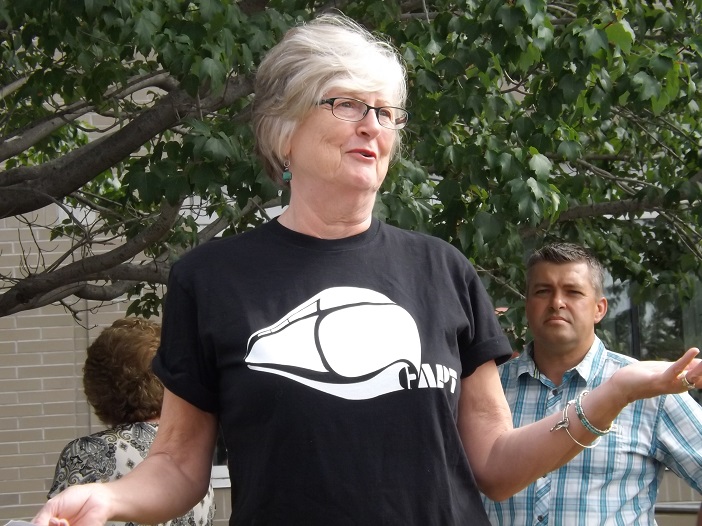Well. What else is there to say about the loss of passenger rail service between Sault Ste. Marie and Hearst? What else can be done to capture the attention of politicians so out of touch with Northern Ontario that they consider the endless kilometers of ruts, wash-outs and isolation on a logging road as ‘accessible road’? How many more petitions, letters of support and resolutions must be sent to the various ministries urging the essential need of and investment in passenger rail service along Algoma Central Rail lines? How many businesses relying on the passenger rail to bring tourists and supplies must collapse? What tragedy –how many tragedies, must occur on these logging roads; on the bluffs that must be climbed; the lakes that must be crossed; the miles of bush that must be hiked to arrive to a family camp; or on an icy, whited-out winding Northern highway as people travel to medical appointments or for a haul of monthly grocery provisions, before Ottawa reinstates the measly 2.2 million dollar subsidy to provide passenger service between the Sault and Hearst?

“We’ve spent four generations at Ogidaki Lake -that’s 65 years. We enjoyed it summer, spring, winter, fall. Now we have to go 12 miles on a terrible road and then cross a lake and then hike 2 miles down to the camp. Or we can take a different road- 12 of the 18 miles is a logging road and then up a bluff and then to our camp. This is remote to me. I don’t understand why the government is saying that it isn’t. I’m 78 years old and I’m little past my best before date for all of this ATV action. The government should get this train operating.” ~Al Johnson
About sixteen people representing the Coalition of Algoma Passenger Trains (CAPT), Northern and Eastern Ontario Rail Network (NEORN) and stakeholders relying on Algoma Central Rail (ACR) passenger service, gathered yesterday on the front lawn of the Federal building in Sault Ste. Marie to repeat the message that passenger rail service is an essential need between the Sault and Hearst. The usual collection of local and regional media were present to hear the perpetual and anguished missive of these past two years but where was the national attention? Unfortunately, the matter of Northerners and their dire need for a sustainable and safe transportation plan isn’t even a blip on big media’s radar.
*****
It all began in January 2014 when the Canadian National Railway Company (CN) announced that they were axing passenger service from Sault Ste. Marie to Hearst. The decision came from Transport Canada who made the decision that the ACR no longer met the criteria for the Remote Passenger Rail Program (RPRP). RPRP “provides funding to ensure that safe, reliable, viable and sustainable passenger rail services are provided to certain areas of the country where these services are the only means of surface transportation for remote communities. At the time the ACR was receiving $2.2 million annually through the RPRP investment.

“Lodges along the line are suffering. With two of the worst years in their histories, they simply cannot last much longer. We are baffled. Why is this rail line no longer their responsibility? Why would they turn their backs on the businesses, the communities and the potential of this rail line?” ~Carol Caputo, Algoma Kinniwabi Travel Association (left)
“We send a lot of people north of us. People travel from all around the world to find our tour and passenger train experiences. This has greatly affected us and we urge the federal government to reconsider their decision so that new money can come into small businesses, our community and Canada.” ~Dean Anderson, owner of Catalina Motel (right)
In response to Transport Canada’s decision, BDO Canada LLP, Chartered Accountants and Advisors, prepared a preliminary report, dated April 11th 2014, Algoma Central Railway Passenger Service: Economic Impact Draft Assessment, “to compile available information and survey data to quickly respond to Transport Canada’s termination of financial assistance.” The overriding goal was “to make a case for and obtain a one year extension of federal support for the ACR service.”
The report found that the RPRP investment enabled $38- $44 million in direct and indirect economic impact and created 170-220 direct and indirect jobs. Moreover, the $2.2 million investment created an additional $2.92 – $4.25 million dollars back to the Federal government in income tax. Annually, the passenger service generated $5.12 -$6.45 million in taxes.
“There’s more going to the government in taxes than what they are paying to passenger rail service,” remarked Dr. Lina Savory-Gordon, co-founder of CAPT. “It’s incomprehensible how they think they can’t afford this,” she remarked of the Federal government.

“Making Sault Ste. Marie more accessible to students will encourage students to study in Sault Ste. Marie which is especially important for small campuses like Sault College and Algoma University. Opening the passenger train will encourage students to study in the North and stay in the North. If I want to return to visit Hearst, I would have to make a 30 hour bus journey from the Sault to Sudbury to New Liskeard to Cochrane and then finally to Hearst. That’s just unreasonable.” ~Brendan Sutherland, Algoma University Student
An extension of the RPRP was granted on April 14th, 2014 and on April 1st, 2015 Transport Canada announced a second extension in funding to the tune of 5.3 million over three years for the continuation of passenger rail service along the Algoma Central Rail. But securing a third party operator to run the service was, nicely put, challenging. An arrangement with Railmark Holdings Inc. went sour when Railmark was unable to obtain financing as per the terms of agreement with the Canadian National Railway resulting in the loss of passenger rail service between the Sault and Hearst- again. Hopes for passenger rail service were renewed earlier this year when Missanabie Cree First Nation Chief, Jason Gautheir, and Keewatin Railway Company in Manitoba, struck a Memorandum of Understanding that outlined a collaboration that could resurrect passenger rails service along the ACR. Essentially Missanabie Cree First Nation would own the train set and Keewatin would be the operator.
On Wednesday, July 20th, hopes were shattered yet again when Transport Canada Minister, Marc Garneau, announced that the Ministry was pulling $5.3 million in support for passenger service between the Sault and Hearst, making claims that most of the communities along the rail line have access to highways and that the RPRP program is available only when rail is the only way to get in and out of an area.
*****
Stakeholders penned a letter to Garneau requesting the immediate reinstatement of the RPRP and all the reasons to do so. The reply back was exasperating, Dr. Gordon stating that the Minister completely “neglected the information”.
“This is what makes us so mad. It’s back to square one,” admitted Dr. Gordon.
“Garneau states that this area is not remote enough anymore, that there are roads in. We have told him that 400 km of the 472 km of that line have no road access. He’s just listening to the bureaucrats at Transport Canada who look at google maps and if they see any road going in they call it a road. But you would think Transport Canada would know the difference between a public road and an industrial logging road,” remarked Dr. Gordon shaking her head. “Also, Garneau states that we don’t have a sustainable plan. We do. And we have an operator.”
According to Dr. Gordon stakeholders are more frustrated than ever and have been making appointments to personally speak with their MP, in the Sault- Terry Sheehan.
Eric Boutilier spokesperson for NEORN was also present yesterday and presented startling facts about passenger rail investment in the province of Canada. The Metrolinx receives a whopping investment of $155.62 per Ontarian. The ACR line between Sault Ste. Marie and Hearst requires a meager .07 cents per Canadian to get back on the track.
“The amount we are asking for the ACR is by no means unreasonable. The Algoma passenger service represents a very modest investment in essential transportation in the Algoma District and along the Algoma Central corridor,” stated Boutilier.
Not only does the tourism industry and job force in the North gain through the investment in passenger service but so does access to education and healthcare services benefit. Links to family, friends, community and the land are supported and the environmental impact is measurable.
“To switch from road travel to rail is one of the fastest ways to reduce carbon emissions,” stated Dr. Gordon. “And this is a corridor that really lends itself to ecotourism too so it encourages people to find solutions to climate change.”
Eight years ago, outdoor adventurer couple and conservationists-Gary and Joanie McGuffin, and art historian-Michael Burtch, set out to retrace and map the Group of Seven’s paths across pristine lakes and the wild northern landscape –just for the love of it. Last year the documentary Painted Land: In Search of the Group of Seven was released. The film retraced the discoveries of the trio as the ‘refound’ the original painting sites of the Group and has since invigorated national pride –especially in the Algoma District.
Burtch was on hand at yesterday’s event and described the reaction to the film and the interest it creates among those who see it. “One of the questions we get is can visitors bring their canoes and camping gear on the train and have the Group of Seven experience themselves. We sadly have to answer ‘no, not at this point in time’! This is a travesty, a travesty made more poignant at a time when the province has launced a new initiative to re-brand the province using the Group of Seven legacy, particularly in Algoma.”

“Townships are locked in between Lake Superior Provincial Park and the railroad. For 35 of 40 years we only had one access to get to our property and that was the railroad and we used it constantly. There was no other way. Now the logging companies have put in a road that I can drive right to my camp –but it’s private property so it’s at the whim of the company if we can use that road. It’s 63 km from the highway to my camp. If there’s no road or you get caught halfway in between you’re in a real jam. When we had the railroad we had an option. We need that railroad as residents of that area and we deserve it. We need the government to put up what they said they would put up for us.” ~ Len Piccolo, Mask-Wa Residents Association
NEORN prepared a ‘supplement’ to accompany the Northern Ontario’s multi-modal transportation strategy – a report that will shape transportation in Northeastern and Northwestern Ontario over the next 25 years.
“One of the reasons we prepared this report is because first- there is very little mention of passenger rail and the need for it in this region. And second- the infrastructure is already in place. Let’s use it,” explained Boutilier.
Boutilier also emphasized that Northern communities are aging communities. The median age in Ontario is 40 years old. In Sault Ste. Marie the median age is 45.7 yrs., in Hearst -45 yrs. and in Elliot Lake -57 yrs.
“It’s great that the government is investing in health and education services but if people can’t access them what good is it?” remarked Boutilier. “We need better transportation opportunities to connect communities in the North with each other and within Southern Ontario to access services that they can’t get here. This is supposed to be a developed nation and we have people that can’t get around. It’s important that the federal government comes to the table and provides this equitable investment that they provide elsewhere in the country.”
*****
An e-petition to be presented to the House of Commons has been initiated by Algoma-Manitoulin-Kapuskasing MP, Carol Hughes. You can sign it by clicking here.
Would you like to voice your concerns about the loss of passenger rail service in the North? Contact your MPP, MP or Transport Canada Minister Marc Garneau.

“I go in on abandoned logging roads- there are two beaver dams right along the road and the water levels are above the road. I don’t know if you can really call them roads- it’s more like ruts. The road has been abandoned by loggers, it’s not public, I don’t know who owns it but we go in on it anyways. The reason there are cottages, lodges and businesses along the line is because the railway is there. That’s how we accessed these places. And now the government says we’re not remote anymore, we’re not going to fund this anymore.” ~Dawne Cunningham, CAPT Chair





